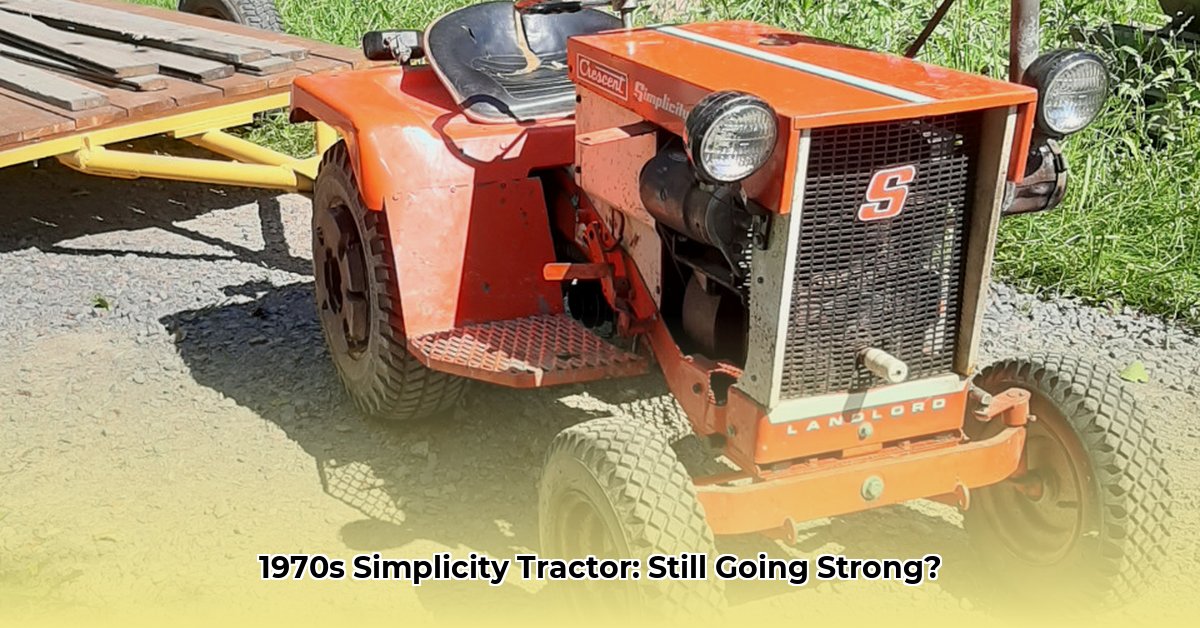
Imagine a world before smartphones, where mowing the lawn felt… different. For many, the 1970 Simplicity lawn tractor was the dependable workhorse. This isn't just a story about a machine; it's a glimpse into a bygone era of quality craftsmanship and surprisingly sustainable practices. We'll explore its design, durability, and surprising relevance in today's world of sustainable gardening. Whether you're a tractor enthusiast, DIYer, or simply curious, you'll find something engaging here. For more on Simplicity's history, check out this 1986 Simplicity Tractor resource.
Simplicity's Enduring Strength: Built to Last
Long before its acquisition, Simplicity Manufacturing built a reputation on rugged reliability. Their tractors weren't flashy; they were built to perform. The 1970 model embodies this philosophy perfectly. These weren't disposable tools; they were built to last, reflecting a time that valued enduring quality over fleeting trends. It's not uncommon to find these tractors still running, decades later, a testament to their robust construction. This is genuine durability, not just marketing. Isn't it remarkable how a machine from 1970 can still be found functioning today? What does this tell us about our current consumption habits?
Under the Hood: A Dependable Workhorse
The heart of the 1970 Simplicity, in most cases, was an 8-horsepower Briggs & Stratton engine (a relatively powerful engine for its time). While not technologically advanced by today's standards, it was dependable and easy to maintain. Think of it as the reliable pickup truck of lawn tractors – maybe not flashy, but always ready to work. Simplicity's design philosophy was simple: straightforward mechanics made repairs accessible to the average homeowner. Parts were readily available, repairs were manageable, and the design prioritized longevity. This meant many tractors were repaired, not replaced, a significant factor in their long-term environmental impact. It also fostered a connection between owner and machine, a relationship often lost with modern, disposable products.
Adapting with the Times: Continuous Improvement
While the core design remained largely unchanged, Simplicity quietly incorporated improvements over the years. Materials evolved, manufacturing techniques were refined, but the fundamental goal—reliable lawn care—remained constant. This wasn't radical redesign; it was evolutionary progress, enhancing performance and efficiency. This steady progression highlights the original design's inherent strength, demonstrating a model of continuous, sustainable improvement, rather than constant reinvention. How did this philosophy of incremental improvement contribute to the tractor’s longevity and environmental impact?
Sustainable Gardening: A Deeper Dive
How "green" is a 1970 Simplicity tractor by today's standards? It's complex. While its longevity reduces environmental impact compared to frequent replacements, a complete assessment requires more data. We lack comprehensive information on manufacturing processes, materials, and the overall lifecycle. Ongoing research is needed to fully assess its footprint. However, the widespread longevity suggests a lower lifetime replacement rate, potentially translating to a more positive long-term environmental impact. This potential for positive environmental impact is a fascinating area for further study. One key factor is the relative ease of repair compared to modern machines, encouraging repair over replacement and reducing discarded machinery.
A Legacy of Quality and Longevity: Lessons for Today
Simplicity, now part of Briggs & Stratton, builds upon this foundation. The 1970 Simplicity is more than a machine; it represents a time when "built to last" wasn't just marketing. It reminds us of a time when products were designed for decades of use, not immediate disposal. Its remarkable endurance prompts reflection on our modern throwaway culture. Does your current lawn equipment possess the same staying power? Perhaps it's time to reconsider our focus on quality and longevity.
Key Takeaways:
- The Simplicity's durability, while offsetting higher initial fuel consumption, depends on several factors such as yard size and preventative maintenance.
- Assessing the environmental impact of older tractors necessitates a holistic review, considering fuel efficiency, repair needs, lifespan, size, and noise pollution.
- Responsible use, proper maintenance, and mindful operation minimize environmental impact.
How to Assess the Environmental Impact of Older Lawn Tractors
The 1970 Simplicity, while impressive, requires a nuanced environmental assessment. Let's delve into how to evaluate the environmental impact of older lawn tractors. Fuel efficiency, maintenance needs, and lifespan are all critical considerations.
Fuel Efficiency: A Balancing Act
Older tractors often consume more fuel than modern models. The Simplicity's consumption varies greatly depending on workload. This directly affects your carbon footprint. However, its long lifespan might offset this higher fuel consumption over time, particularly if covering a large area. What is a reasonable expectation of fuel consumption for this model, and how does it compare with modern alternatives?
Maintenance: Long-Term Costs and Sustainability
While robustly built, the Simplicity requires maintenance. Potential issues can be costly. These repairs—parts, labor, transportation—have their environmental cost. However, a well-maintained tractor can last decades, reducing the need for replacements. How does the long-term maintenance cost of this tractor compare to the cost of multiple replacements of more modern but less durable machines?
Size Matters: Right Tool, Right Job
Consider your lawn's size. A large tractor on a small lawn leads to unnecessary fuel use and potential damage. Choosing the right size machine significantly reduces environmental impact. What should you consider in size and power to ensure environmentally responsible use of these machines?
A Holistic Assessment
Assessing the impact requires considering:
- Fuel efficiency: How much fuel does it use?
- Maintenance needs: Are there potential issues?
- Lifespan: How long will it last?
- Size: Is it appropriate for your lawn?
- Noise pollution: Older tractors can be noisy.
A pre-purchase inspection is crucial to avoid unexpected costs. Will this investment be environmentally responsible relative to the alternatives?
The Verdict: A Case-by-Case Analysis
Buying a used Simplicity Legacy can be worthwhile, if you consider maintenance costs, fuel efficiency, and the size of your lawn. For large properties, it could yield a smaller long-term environmental impact compared to frequent replacements. However, for smaller yards, a more compact and efficient model may be the greener choice. What factors should ultimately guide your decision-making process?